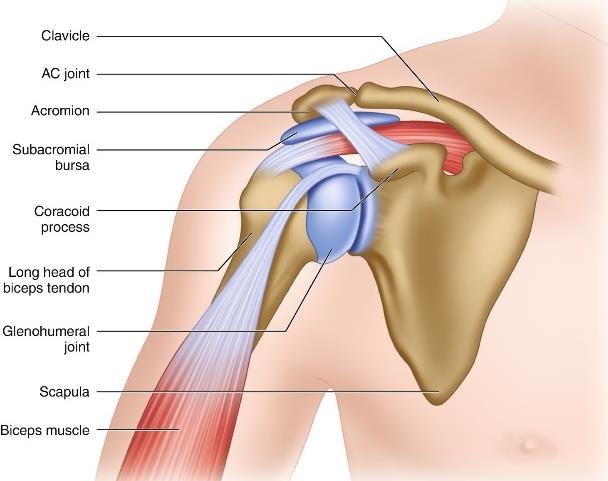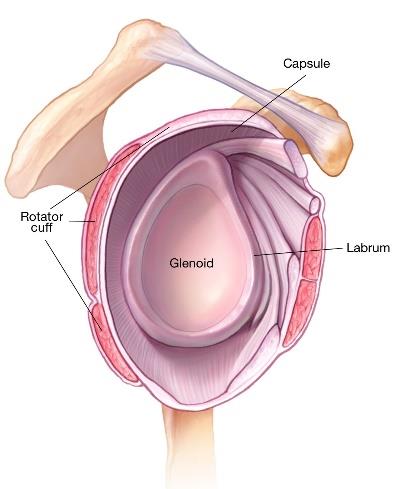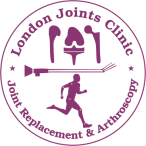Shoulder Anatomy &
Common Shoulder Problems
What is the anatomy of the shoulder joint?
The shoulder joint is a ‘ball and socket’ type of joint that is highly mobile and allows the arm and hand to be moved in several planes. It is formed by a shallow socket called the glenoid, which is a part of the shoulder blade. The ball is formed by the upper end of the arm bone called the head of the humerus. The articulating surfaces of these bones are covered with a specialised coating that is shiny white and slippery. It is called the articular cartilage and it allows smooth, frictionless and painless motion of the shoulder joint.
A ring of fibrous tissue, called the labrum, completely encircles the shallow glenoid and makes it deeper. It forms a type of suction cup for the humeral head and gives it stability. Additionally, there is a long tendon coming into the shoulder joint from the arm. It is attached to the top of the glenoid and firmly blends with labrum. This tendon is called the long head of biceps tendon.


The shoulder joint is enveloped by a band of tissues called the capsule. This is thickened at few areas within the shoulder to form the supporting ligaments. The inner surface of the joint capsule is covered with a special layer called the synovium, which produces a special fluid called synovial fluid that helps lubricate the shoulder joint.
There are four muscles that arise from the shoulder blade and help in rotations of the shoulder. The tendons of these four muscles are attached to the head of the humerus in an orderly fashion and surround it just like the cuff of a shirt surrounds the wrist. These group of tendons is called the rotator cuff.
The area between the top of the shoulder joint and the under-surface of the bone of shoulder tip (acromion) is called the subacromial space. This space has a lubricating sac called the subacromial bursa that sits atop the rotator cuff. This bursa helps in the smooth gliding movements of the rotator cuff whenever the arm is moved.
The clavicle or collar bone is located in front of the shoulder. It forms two joints on either side due to its articulations with the surrounding bones. The acromio-clavicular joint (AC Joint) is located on the outer side just above the shoulder joint. It is formed between the outer end of the clavicle and a part of the shoulder blade called the acromion (tip of shoulder).
The sterno-clavicular joint (SC joint) is formed due to the articulation of the inner end of clavicle with the sternum (breastbone). The SC ligaments provide stability to this joint.
The AC joint has several acromio-clavicular (AC) ligaments connecting the two bones. Additionally, there is the coraco-clavicular (CC) ligament running between the under surface of the outer clavicle to the arch of the coracoid bone underneath the clavicle. This CC ligament has a conoidal part (cone like part on the inner side of the clavicle) and a trapezoidal part (on the outer side), providing stability to the AC joint.
The commonly occurring shoulder problems are:
The commonly occurring shoulder problems are:
- Shoulder instability & dislocations – first time and recurrent dislocations
- Rotator cuff tendonitis and tears
- Impingement Syndrome (Bursitis)
- Glenohumeral joint arthritis due to osteoarthritis, rheumatoid arthritis, post-traumatic arthritis
- Cuff tear arthropathy
- Adhesive capsulitis (Frozen Shoulder)
- Calcific Tendonitis
- Labral tears – (SLAP tears, Anterior and Posterior Bankart Lesions)
- Biceps – tendonitis, subluxation, dislocations and tears
- Acromioclavicular ligament sprains and dislocations
- Acromioclavicular joint arthritis
- Little leaguer’s shoulder
- Fractures around shoulder joint
- Osteonecrosis or Avascular necrosis of humeral head
Book An Appointment
Private Clinics : Locations & Directions
London Joints Clinic (Pune)
Address
Office S 5, 2nd Floor, North Block, Sacred World Mall,
Opp Sacred Heart Township, Near Jagtap Chowk,
Wanawadi, Pune 411040
Monday to Saturday
6 PM to 9 PM
Appointments
Hospitals OPDs : Locations & Directions
Jupiter Hospital (Baner)

Address
Lane 3, Baner- Balewadi Road,
Prathamesh Park,
Baner, Pune 411 045
Monday to Saturday 11 AM to 4 PM
Appointments
Contact us
Dr Anand Jadhav has a centralised appointment system for all locations across various hospitals and clinics in Pune & PCMC areas
Appointment Bookings & Requests can be made by any method :

